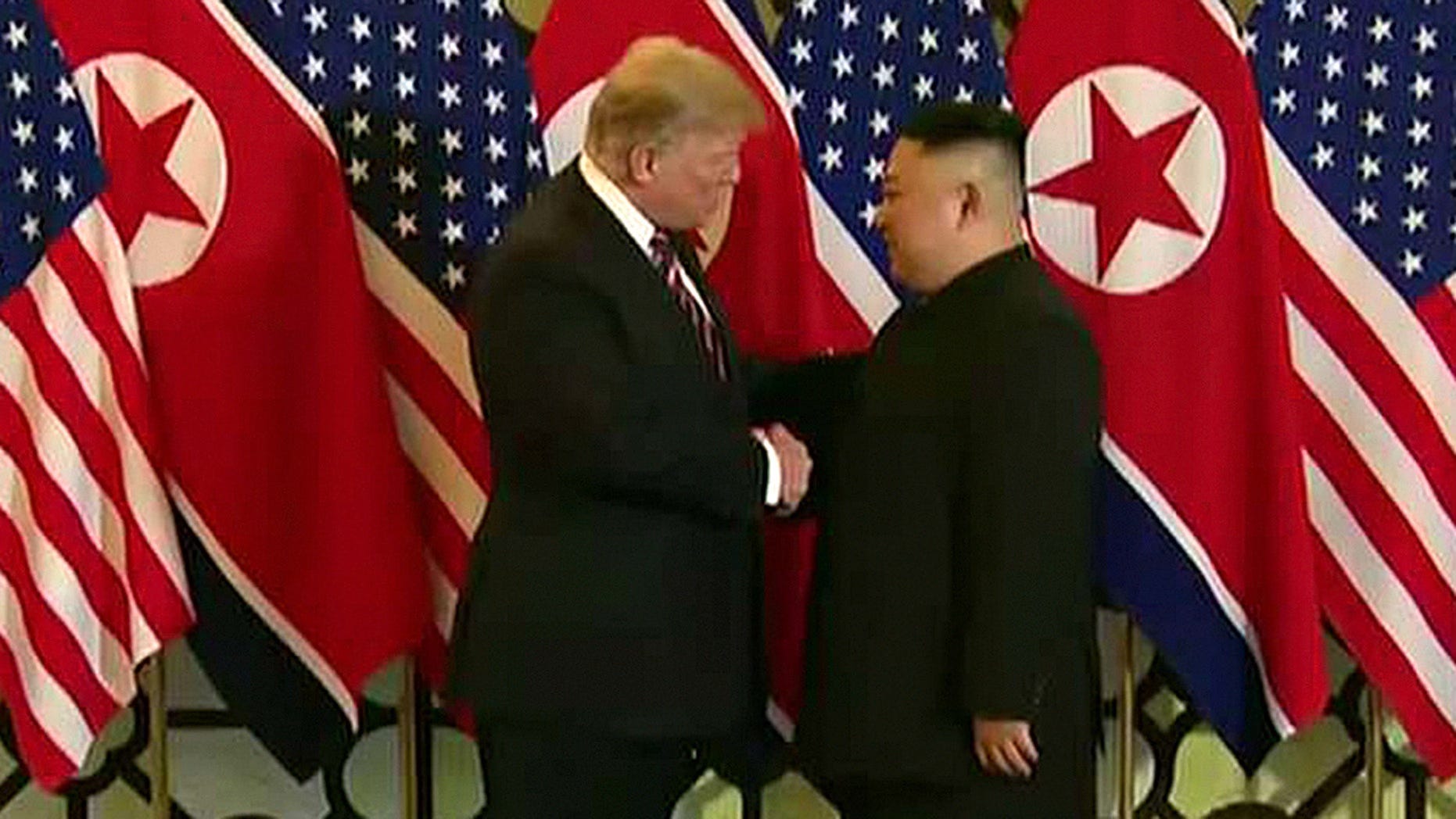
IT WAS EARLY IN HIS PRESIDENCY, during one of his regular morning intelligence briefings, that Donald Trump proposed a bizarre approach to dealing with the threat from North Korea.

“Why don’t we take out the whole North Korean Army during one of their parades?” Trump asked, according to the recently published memoir by his former White House national security advisor H.R. McMaster.
The idea of attacking North Korea soldiers marching in a parade was stunning, to be sure. But it was of a piece with the kind of unhinged talk Trump was often prone to on the subject of Korea—even at one point reportedly suggesting to his then chief of staff John Kelly that the U.S. drop a nuclear bomb on the country and then avoid responsibility by blaming the strike on another (unnamed) country.
Whatever Trump was doing when he talked like this—and McMaster lamely argues the commander in chief was simply trying to shock his briefers—his by now well documented comments are a reminder of a mostly forgotten chapter of Trump’s dealings with the Hermit Kingdom.
It’s a chapter well worth remembering for clues into how Trump might handle a future national security crisis—on the Korean peninsula or anywhere elsewhere around the globe—should he be returned to the presidency following next month’s election.
For most Americans, the indelible memory of Trump’s approach to North Korea was his bromance with the country’s dictator Kim Jung Un—their summits in Singapore and Hanoi and their “love letter” correspondence that Trump was so fond of that he took the letters with him to Mar-a-Lago after leaving office, which in part triggered the FBI’s decision to raid the complex in search of the pilfered documents.
But before he tried to seduce Kim, as national security journalist Zach Dorfman vividly reminds us in a new SpyTalk podcast and in a recent piece for Rolling Stone, Trump came perilously close— closer than anybody quite realized at the time—to embroiling the United States in a full scale war.
“We have all lived in such a memory hole that 2017 seems like many decades ago,” Dorfman tells me. “When I went back to actually research this piece, I was shocked…Things were a lot more dangerous than people understood.”
Escalation Ladder
There’s little question that relations with North Korea were tense when Trump took office. Barack Obama had warned him, in their one meeting at the White House, that dealing with North Korea and its growing nuclear arsenal would be the most urgent problem he would face as president. Then, after taking office, Kim ratcheted up his missile program, firing off repeated tests, including an intercontinental ballistic missile in July that flew for 40 minutes before landing in the Sea of Japan. (“Nothing ruins a Fourth of July holiday quite like a North Korean ballistic missile test,” McMaster writes in his book.)
Trump, on the advice of McMaster and others, ordered up a full scale campaign of “maximum pressure” on the country, complete with punishing sanctions. The novice president went fully public with his bellicose rhetoric warning that if the North Koreans didn’t cut it out, “they will be met with fire and fury, and frankly, power the likes of which this world has never seen before.”
North Korea responded within a few hours by announcing it was considering creating “an enveloping fire” around Guam by striking a U.S. air base on the Pacific island. Secretary of Defense Jim Mattis worried that Trump’s policies would result in a nuclear exchange, “incinerating a couple of million people,” according to Bob Woodward’s book, Rage.
In fact, as Dorfman discovered in the course of his reporting, the public war talk was only the half of it. As part of his “maximum pressure” campaign, the White House ordered up a full scale review of war plans for North Korea, complete with directives to assassinate the country’s leadership. At the same time, CIA director Mike Pompeo began actively updating his own agency’s plans for paramilitary officers to serve as the “tip of the spear” of a U.S. invasion whose ultimate goal was nothing short of regime change.
“This was undertaken by senior officials within the CIA’s Special Activity Center,” says Dorfman, a widely published intelligence-affairs reporter, former senior staff writer at the Aspen Institute and senior fellow at the Carnegie Council for Ethics in International Affairs. But the plans for CIA paramilitary operatives to be seconded into a Joint Special Operations Command (JSOC) invasion team led to bureaucratic tensions and, even more—bewilderment at how flimsy the ideas were.
Nuts
“My CIA sources told me, we could not believe how fanciful and rudimentary these [plans] were. They hadn’t been updated in decades. They were ludicrous. The Pentagon was like, ‘We’ll just have CIA guys riding with us on tanks and then they’ll go up into the hills and recruit like hill people because hill people don’t like city dwellers. They’re literally talking like a Vietnam-era war playbook.”
Whether these plans have gotten any sharper and less fanciful is far from clear. But largely unnoticed on a world stage that is rife with conflicts—in the Mideast, Ukraine and the South China Sea—the threat of another one with North Korea hasn’t gone away. In fact, it’s only been intensifying.
Kim has been expanding and updating his nuclear arsenal and is now estimated to have 50 to 60 nuclear weapons. He has also been intensifying his ballistic missile tests and declared he’s no longer interested in formal “reunification” with South Korea—as opposed to simply taking it over. He’s strengthened his alliance with Vladimir Putin’s Russia, sending equipment and even troops to fight in Ukraine, solidifying his position in the “axis of resistance” to the United States.
“The situation on the Korean Peninsula is more dangerous than it has been at any time since early June 1950,” two Korea scholars, Robert Carlin and Siegfried Hecker, wrote earlier this year in an article for the Stimson Center, a Washington-based think tank. “That may sound overly dramatic, but we believe that, like his grandfather in 1950, Kim Jong Un has made a strategic decision to go to war.”
While that assessment is debated among the small community of specialists who follow such matters, it raises an equally pressing question: If Trump wins, which version of him will guide U.S. policy? The peacenik who embraced Kim and sought to engage him in diplomacy? Or the unhinged warrior who talked of unleashing “fire and fury” on the country?
Certainly, Trump’s transformation as president was head spinning. And Dorfman, for his part, says it’s hard to accept Trump’s overtures to Kim as all that comforting when one looks closely at what preceded it.
“The difficulty with me in reconciling” Trump’s interest in avoiding a nuclear war “is that the rhetoric in 2017, when he was president, the first year of his office or so, was so extraordinarily overheated,” Dorfman says.
“People say that, well, maybe it’s the madman theory coming to life,” he adds. “But I have no historical analog in modern American history of somebody publicly threatening a nuclear armed power with nuclear obliteration over and over and over again to basically, you know, switch—yeah, flip±like that. Maybe it’s a negotiating technique, but I don’t know.”
Nor, for that matter does anybody else—one reason, among many, that voting in this election just might be a life or death gamble.
You can listen to the whole conversation here on Simplecast, or Apple, or whatever your preferred podcast platform.

